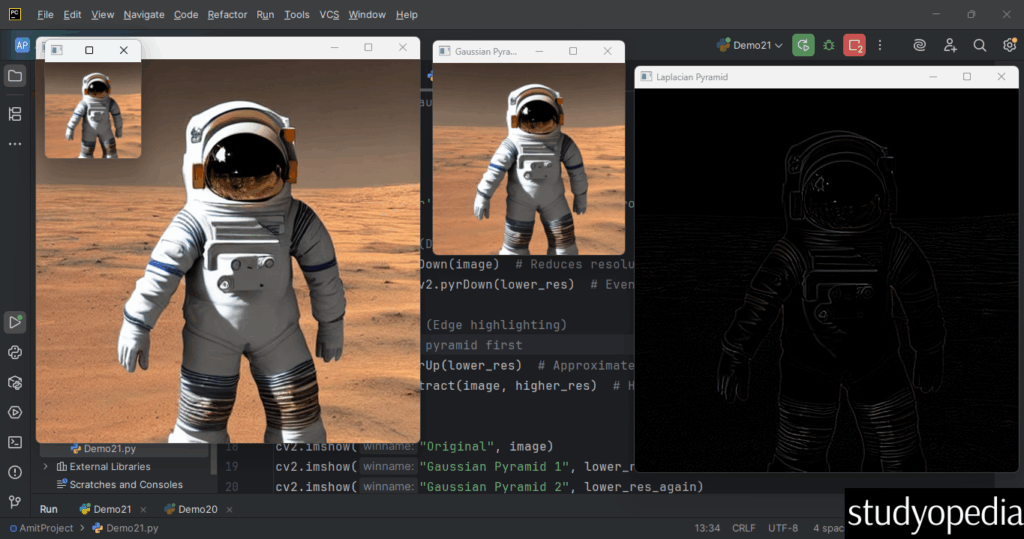21 May Image Pyramids (Gaussian & Laplacian) with OpenCV
Image pyramids are multi-scale representations of an image that allow processing at different resolutions. They’re widely used in computer vision tasks like image blending, object detection, and texture synthesis. It is used for multi-scale image processing (e.g., image blending, resolution reduction).
Practical Applications of Image Pyramids
- Image Blending (e.g., seamless cloning)
- Multi-scale object detection
- Texture synthesis
- Image compression
Gaussian Pyramid
A Gaussian pyramid is a sequence of images where each level is a smoothed and downsampled version of the previous level.
How it works:
- Apply Gaussian blur to the current level
- Downsample the image by removing every even-numbered row and column
- Repeat the process to create subsequent levels
Laplacian Pyramid
A Laplacian pyramid is formed by the difference between levels in the Gaussian pyramid. It captures detail information at each scale.
How it works:
- Build the Gaussian pyramid
- For each level (except the last), subtract the expanded version of the next level
- The Laplacian pyramid stores these different images
Let us see an example of implementing the Gaussian and Laplacian Pyramid:
|
1 2 3 4 5 6 7 8 9 10 11 12 13 14 15 16 17 18 19 20 21 22 23 24 25 26 |
# Image Pyramids (Gaussian & Laplacian) import cv2 # Load image image = cv2.imread(r'C:\Users\hp\Downloads\Astronaut.png') # Gaussian Pyramid (Downsampling) lower_res = cv2.pyrDown(image) # Reduces resolution by half lower_res_again = cv2.pyrDown(lower_res) # Even smaller # Laplacian Pyramid (Edge highlighting) # Requires Gaussian pyramid first higher_res = cv2.pyrUp(lower_res) # Approximates original size (blurry) laplacian = cv2.subtract(image, higher_res) # Highlights edges # Display results cv2.imshow("Original", image) cv2.imshow("Gaussian Pyramid 1", lower_res) cv2.imshow("Gaussian Pyramid 2", lower_res_again) cv2.imshow("Laplacian Pyramid", laplacian) cv2.waitKey(0) cv2.destroyAllWindows() |
Output

Key Points
- Gaussian pyramid provides a multi-resolution representation
- Laplacian pyramid captures detail information at different scales
- pyrDown() reduces resolution (smooths then downsamples)
- pyrUp() increases resolution (upsamples then approximates missing data)
- The original image can be reconstructed from the Laplacian pyramid
If you liked the tutorial, spread the word and share the link and our website Studyopedia with others.
For Videos, Join Our YouTube Channel: Join Now
Read More:
- Apply Sepia Tone filter with OpenCV
- Generative AI Tutorial
- Machine Learning Tutorial
- Deep Learning Tutorial
- Ollama Tutorial
- Retrieval Augmented Generation (RAG) Tutorial
- Copilot Tutorial
- Gemini Tutorial
- ChatGPT Tutorial


No Comments